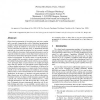151 search results - page 1 / 31 » Using trust and risk in role-based access control policies |
JHSN
2006
13 years 9 months ago
2006
We present a refined model for Role Based Access Control policies and define a risk measure for the model, which expresses elements of the operational, combinatorial and conflict ...
WORDS
2005
IEEE
14 years 3 months ago
2005
IEEE
This paper presents a framework for verifying the access control requirements of real-time application systems such as workflow management systems and active databases. The tempor...
SP
2002
IEEE
13 years 9 months ago
2002
IEEE
We introduce the RT framework, a family of Rolebased Trust-management languages for representing policies and credentials in distributed authorization. RT combines the strengths o...
SACMAT
2004
ACM
14 years 2 months ago
2004
ACM
Emerging trust and risk management systems provide a framework for principals to determine whether they will exchange resources, without requiring a complete definition of their ...
NSPW
1998
ACM
14 years 1 months ago
1998
ACM
Object-based programming is becoming more and more popular and is currently conquering the world of distributed programming models. In object-based systems access control is often...

